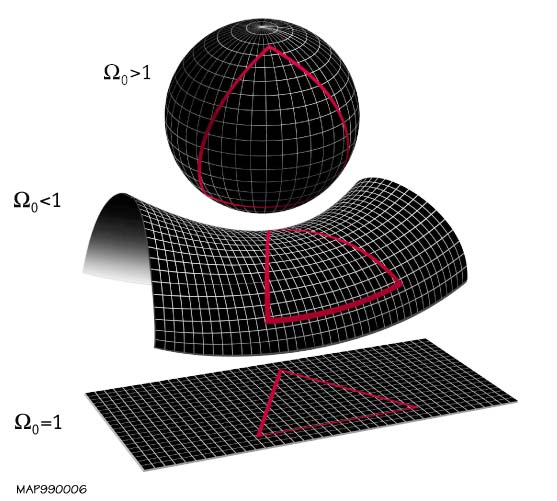When you stare up at the stars from an empty field, or from the top of a mountain, well away from the light pollution of cities and roads, it is truly a marvelous sight. The stars seem to form a heavenly dome above your head, twinkling down at you from the massive, endless expanse of space.
In our explorations of outer space, we have made some amazing discoveries – black holes, dark matter, galaxies containing hundreds of billions of stars, and spectacular nebulae. We can place all of these celestial objects in a relative “map” in relation to our planet, but try thinking outside the box a bit….
Think beyond our planet, solar system, galaxy, and even the universe. Imagine stepping outside of the universe and peering down like some sort of extra-universal super-being. The million-dollar question, of course, is….what would you see? What is the shape of the universe?
Mind-Boggling and Fascinating
It can be difficult for human beings to conceive the vastness of space. At a certain point, the massive distance and scope of the term “infinite” become too great; a relative perspective becomes almost impossible. Furthermore, that confusion happens when we are still discussing things within our universe, let alone when considering the idea of stepping outside of it! Fortunately, there are a number of scientists who enjoy stretching their brains to those incredible proportions, and while we don’t have a definite answer to this head-scratching question, we do have a few possible answers…
Einstein… As Always
Whenever theories or debates about space arise, it seems like Albert Einstein’s name inevitably pops up, and this particular question is no different. To understand the shape of the universe, we need to dip our toes into Einstein’s theory of general relativity. If you think you already understand it well enough, this is what that German genius has to say…
In extremely simple terms, Einstein posited that space, time, mass, and energy were inextricably linked. He argued that gravity can bend light, affect time, and even determine the shape of space itself. Gravity is generated by objects with mass, so the next logical step in that argument is that mass can change the curve of space.
Since the universe, as we know it, is filled with celestial objects and bodies that possess mass, space also has a density (the amount of mass spread over the amount of volume). The important factor here is “critical density”, which is the point where the universe is said to be “balanced”. This critical point is calculated based on the expansion rate of the universe.
Now, when the Big Bang occurred, and for the approximately 14 billion years since then, the universe has been expanding rapidly (some even say it’s speeding up!). Scientists have observed that everything in space appears to be flying away from everything else (on a grand scale). The great question of our modern astronomical age is whether that expansion is going to continue, stop, or reverse.
That is precisely where this discussion of the universe’s shape gets interesting.
Our Three Possible Universes
So, now we know that we have a “critical density” of the universe, but what about the actual density (calculated based on mass and volume)? Well, since we can only observe roughly 14 billion light years in any direction from an observable point, scientists have a rather good idea of the “observable universe”, but that means we only know the volume and the estimated mass of the observable universe. Hence, the uncertainty, and the three following possibilities…
Option 1: Actual Density Greater than Critical Density – In this scenario, the shape of the universe is a perfect sphere. Essentially, the universe contains enough mass to eventually stop the expansion, which has been moving outwards from the point of the Big Bang. This version is called a “closed universe”, with no beginning or end (a sphere). Eventually, the expansion will reverse, and we will experience the opposite of the Big Bang, with the entire universe compressing in on itself. This uncomfortable fate is popularly called “The Big Crunch”.
Option 2: Actual Density Less than Critical Density – In this scenario, the shape of the universe is the same as a saddle, or a hyperbolic form (in geometric terms). Here, the universe doesn’t have enough mass to stop the expansion, and it will continue expanding outwards forever. This version is called an “open universe”.
Option 3: Actual Density Equals Critical Density – In this scenario, the shape of the universe is completely flat and infinite. While this seems like the least likely (that the two densities are just perfectly balanced), this is actually the most popularly assumed theory in scientific circles. The expansion will slow down gradually, perhaps over tens or hundreds of billions of years, until a stasis point is achieved, but there will be no great contraction or “Crunch”.

Shape of Universe where Ω is the density parameter (Credits:NASA/Wikipedia)
What Does This Mean for Us?
While it’s a lot of fun to think of our role in the grand cosmic displays above our heads, the truth is, the shape of the universe and the various density measurements discussed above will never affect our lives. Again, it is difficult to comprehend the scale of light years and the universe, and it is almost impossible to conceive billions of years. Whether we end up stretched out into an icy, infinite, frozen universe, or crunched back down into a singularity, we certainly won’t be around to see it. We can guess at the answers, but we are still limited by the observable universe and mystified by the hundreds of other unexplained phenomena and anomalies of the cosmos.











 That's What artificial gravity Is
That's What artificial gravity Is














